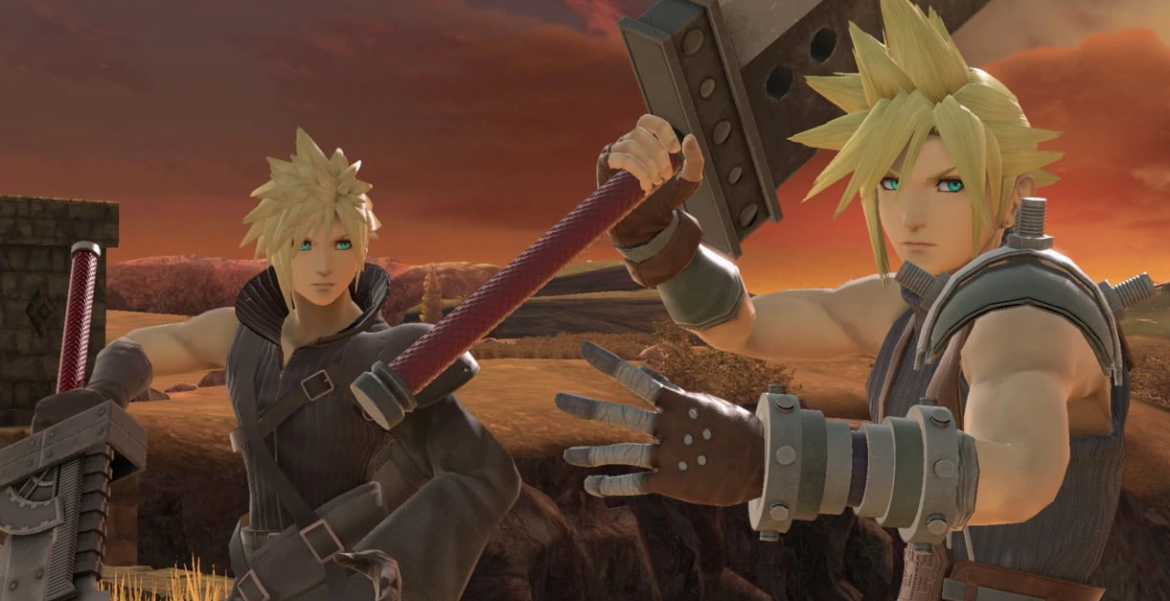And why he’ll likely never be topped as a guest character.
Ever since Solid Snake dialed into Super Smash Bros. Brawl, the series has gone from a who’s who of Nintendo favorites to a crossover franchise that even the Marvel Cinematic Universe can’t touch. Konami, Capcom, Bandai Namco, Sega and even PlatinumGames reps battle it out against the likes of Mario and Link. Snake kicked things off with a bang, launching a guest-fest like no other in Brawl, with additions like Pac-Man and Mega Man joining the roster over the years. The most puzzling and evocative character inclusion, however, comes from Square-Enix in the form of Cloud Strife.
Cloud is a living symbol of Nintendo’s folly.
As the protagonist of one of the biggest PlayStation games of all time, it can’t be said enough how jarring and intriguing it is that he made it into Super Smash Bros. to begin with. But how did we get there?
“Nintendo’s hubris nearly cost them everything”
Final Fantasy’s formative years were on Nintendo platforms, but Final Fantasy VII marked a serious departure for the franchise for myriad reasons. It was a maturation of video games as a medium, having movie-esque trailers and ads during primetime television. Up until this point, video games were locked to Saturday morning cartoons and kids TV blocks almost exclusively.
In 1997 the halcyon days of Nintendo ruling the roost and Saturday morning cartoons were recent memories. Squaresoft took a huge risk with Final Fantasy VII, and to say that it paid off was an understatement. It was a brand new day for both Squaresoft and Final Fantasy.

Final Fantasy VII started development on the Nintendo 64, as Squaresoft made a functional demonstration of certain portions of Final Fantasy VI on the system. Press demos are one thing, but Square were looking for more power, space, and creativity out of the hardware they were working with.
Enter Sony: The electronic powerhouse had already been infamously burned by Nintendo, backing out of their disc-based attachment for the Super Nintendo after it had already been shown to the world. Nintendo stuck with cartridges for the Nintendo 64, which led to Square moving on to the PlayStation.
PlayStation went on to define the next decade of console gaming, with Nintendo failing to eclipse even half of the original PlayStation’s monumental sales. While Nintendo still had many hits on their hands for years to come, PlayStation kept its momentum through the early and mid 2000s.
Nintendo’s hubris nearly cost them everything, and Final Fantasy VII was one of the biggest games in PlayStation history, selling over 11 million copies in its lifetime. It was the quintessential JRPG, the entrypoint for millions of players into an entire genre.
“There will never be another reveal quite like Cloud’s.”
Needless to say, Final Fantasy VII was the poster-child for how Nintendo’s arrogance and oversight almost shoved them out of the console games market.
That poster-child would find his way back to the “house that N built”. His reveal trailer starts by mirroring the iconic Final Fantasy VII intro cinematic, but it wasn’t until the Super Smash Bros. logo faded that the shock set in.
Cloud’s coming to Super Smash Bros., with his own stage, Midgar, to boot!

In typical Super Smash Bros. fashion, he’s incredibly faithful to his source material, from his moveset to his costume design. A huge factor in Cloud’s reveal is that he wasn’t leaked at all leading up to his announcement in an innocuous Nintendo Direct. Ryu and Roy had some haphazard update files data-mined and spoiled for everyone. Even Super Smash Bros. Ultimate couldn’t be saved from the occasional slip-up. Cloud’s reveal was no leaky ship.
We’ve seen many more guest characters join the fray since Cloud in 2015 – Simon Belmont, Terry Bogard, Ken Masters – with another wave of DLC offering the promise of more guests.
These days, we get hype-inducing trailers and extraordinarily detailed breakdowns by Masahiro Sakurai himself. While Sonic the Hedgehog was certainly a surprise, the blue blur had been appearing on Nintendo platforms for almost a decade by the time Brawl released. Not unlike Persona 5’s Joker, with connections to Nintendo in the form of Persona Q2 and Persona 5 Scramble, Cloud was relegated to occasional Final Fantasy spinoff titles until Smash.
There will never be another reveal quite like Cloud’s.
The newest wave of DLC characters are not handpicked by Masahiro Sakurai, but by Nintendo. This means it’s mor9e likely that selected characters will either represent contemporary Nintendo properties, or characters who simply appear on Switch games – even Cloud retroactively fits the latter with a Switch port of his debut game. While the original Final Fantasy VII made its way to the Nintendo Switch years after his Super Smash Bros. introduction, that’s likely all we’ll ever see of Cloud on that platform. There’s a level of uniqueness and charm from how Cloud was doled out that we simply won’t get anymore.
Dylan Tierney spends too much time making podcasts, writing, and postulating about Dragon Ball Z. You can argue with him @tierknee.






